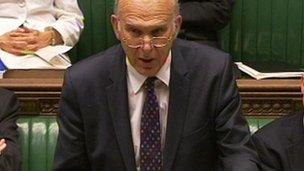Executive pay rules 'could have unintended consequences'
- Published

The business secretary wants pay levels to better reflect performance
Vince Cable wants to compel UK listed companies to disclose one single figure for the earnings of each director in any year, to try to make the often complex pay awards more transparent.
But David Ellis, head of the remuneration practice at KPMG, argues this could have unintended effects.
We have precedent which shows that even the most well-intentioned efforts to improve corporate governance and transparency of pay can lead to consequences that no party intended.
For example, the major push in the mid-1990s to compel companies to disclose further and further levels of detail on directors' earnings was arguably a contributing factor to the ratcheting up of directors' pay in subsequent years.
The increased disclosure led to increased visibility, which in turn led to an increased desire to pay above the median, or mid-point, to retain key talent. Not all companies can pay above the median - for obvious reasons.
The problem with disclosing one figure for aggregate earnings rests in how it is calculated.
Whilst it is clear how base salary or annual bonus should contribute towards the aggregate, it is less clear how one should approach deferred pay or long-term incentives, which are awarded over time subject to performance.
By disclosing one number for aggregate pay, the line between those amounts an executive has taken home in a particular year and those which he or she may receive in subsequent years if the company performs, is blurred.
Pay rise risk
How does the law of unintended consequence apply to this?
There is a big difference between cash paid in one year, cash that may be paid in subsequent years subject to performance, and gains realised that relates to previous years' performance (i.e. which were earned some years ago).
By producing an aggregate figure for pay, we run the risk of treating base pay and performance pay as the same. They are not.
A director with a relatively low figure for aggregate remuneration may compare favourably to one with a higher figure - but not when the composition of the package is looked at more closely.
The key to making this proposal work is keeping a very clear distinction between amounts earned in the year, performance pay earned for previous years' performance, and performance pay that may be earned for future years' performance.
If we do not keep this distinction clear (and the current proposals suggest that this level of separation will not be required), history tells us we will see base pay creep up - a consequence that Vince Cable can in no way have intended.
<italic>The opinions expressed are those of the author and are not held by the BBC unless specifically stated. Links to external sites are for information only and do not constitute endorsement. </italic>
- Published20 June 2012
- Published13 June 2012
- Published8 May 2012